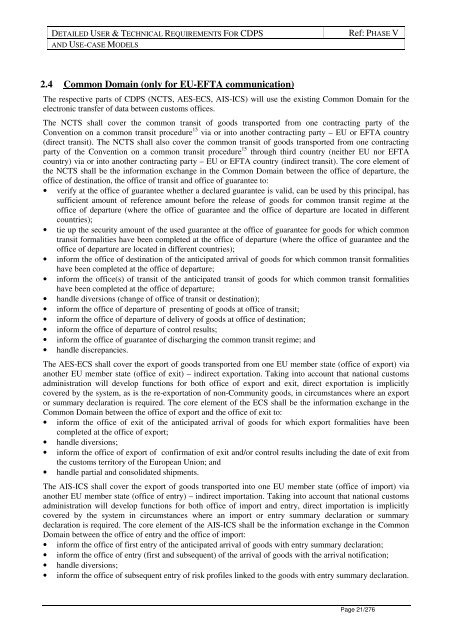Customs Declaration Processing System Detailed User and ...
Customs Declaration Processing System Detailed User and ...
Customs Declaration Processing System Detailed User and ...
You also want an ePaper? Increase the reach of your titles
YUMPU automatically turns print PDFs into web optimized ePapers that Google loves.
DETAILED USER & TECHNICAL REQUIREMENTS FOR CDPS<br />
AND USE-CASE MODELS<br />
Ref: PHASE V<br />
2.4 Common Domain (only for EU-EFTA communication)<br />
The respective parts of CDPS (NCTS, AES-ECS, AIS-ICS) will use the existing Common Domain for the<br />
electronic transfer of data between customs offices.<br />
The NCTS shall cover the common transit of goods transported from one contracting party of the<br />
Convention on a common transit procedure 15 via or into another contracting party – EU or EFTA country<br />
(direct transit). The NCTS shall also cover the common transit of goods transported from one contracting<br />
party of the Convention on a common transit procedure 15 through third country (neither EU nor EFTA<br />
country) via or into another contracting party – EU or EFTA country (indirect transit). The core element of<br />
the NCTS shall be the information exchange in the Common Domain between the office of departure, the<br />
office of destination, the office of transit <strong>and</strong> office of guarantee to:<br />
• verify at the office of guarantee whether a declared guarantee is valid, can be used by this principal, has<br />
sufficient amount of reference amount before the release of goods for common transit regime at the<br />
office of departure (where the office of guarantee <strong>and</strong> the office of departure are located in different<br />
countries);<br />
• tie up the security amount of the used guarantee at the office of guarantee for goods for which common<br />
transit formalities have been completed at the office of departure (where the office of guarantee <strong>and</strong> the<br />
office of departure are located in different countries);<br />
• inform the office of destination of the anticipated arrival of goods for which common transit formalities<br />
have been completed at the office of departure;<br />
• inform the office(s) of transit of the anticipated transit of goods for which common transit formalities<br />
have been completed at the office of departure;<br />
• h<strong>and</strong>le diversions (change of office of transit or destination);<br />
• inform the office of departure of presenting of goods at office of transit;<br />
• inform the office of departure of delivery of goods at office of destination;<br />
• inform the office of departure of control results;<br />
• inform the office of guarantee of discharging the common transit regime; <strong>and</strong><br />
• h<strong>and</strong>le discrepancies.<br />
The AES-ECS shall cover the export of goods transported from one EU member state (office of export) via<br />
another EU member state (office of exit) – indirect exportation. Taking into account that national customs<br />
administration will develop functions for both office of export <strong>and</strong> exit, direct exportation is implicitly<br />
covered by the system, as is the re-exportation of non-Community goods, in circumstances where an export<br />
or summary declaration is required. The core element of the ECS shall be the information exchange in the<br />
Common Domain between the office of export <strong>and</strong> the office of exit to:<br />
• inform the office of exit of the anticipated arrival of goods for which export formalities have been<br />
completed at the office of export;<br />
• h<strong>and</strong>le diversions;<br />
• inform the office of export of confirmation of exit <strong>and</strong>/or control results including the date of exit from<br />
the customs territory of the European Union; <strong>and</strong><br />
• h<strong>and</strong>le partial <strong>and</strong> consolidated shipments.<br />
The AIS-ICS shall cover the export of goods transported into one EU member state (office of import) via<br />
another EU member state (office of entry) – indirect importation. Taking into account that national customs<br />
administration will develop functions for both office of import <strong>and</strong> entry, direct importation is implicitly<br />
covered by the system in circumstances where an import or entry summary declaration or summary<br />
declaration is required. The core element of the AIS-ICS shall be the information exchange in the Common<br />
Domain between the office of entry <strong>and</strong> the office of import:<br />
• inform the office of first entry of the anticipated arrival of goods with entry summary declaration;<br />
• inform the office of entry (first <strong>and</strong> subsequent) of the arrival of goods with the arrival notification;<br />
• h<strong>and</strong>le diversions;<br />
• inform the office of subsequent entry of risk profiles linked to the goods with entry summary declaration.<br />
Page 21/276
















